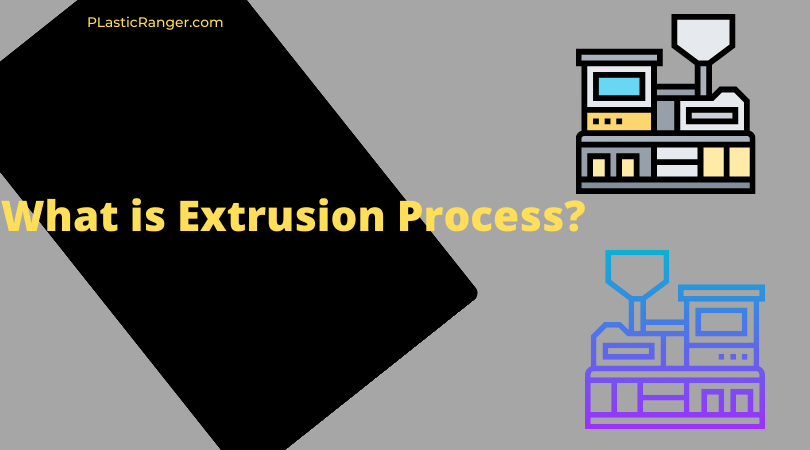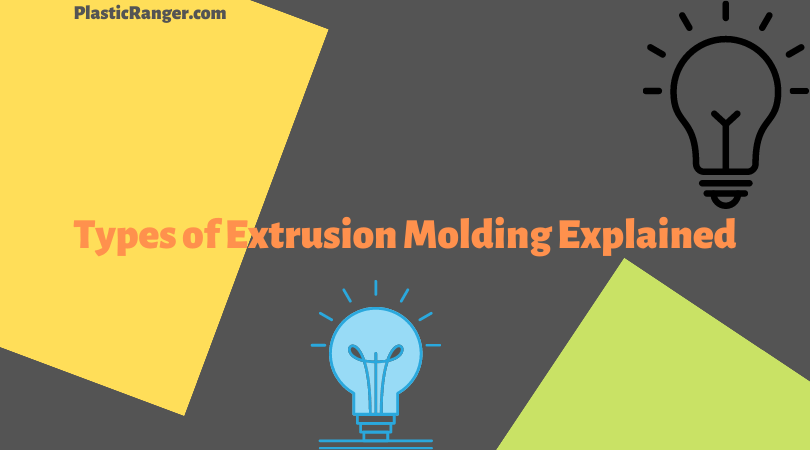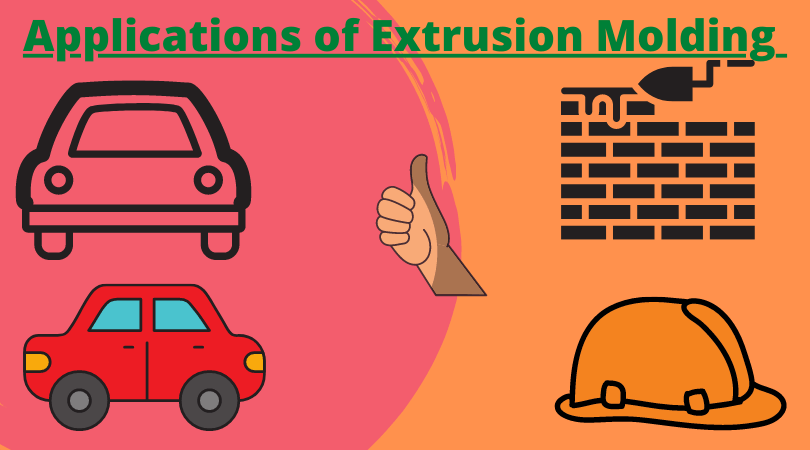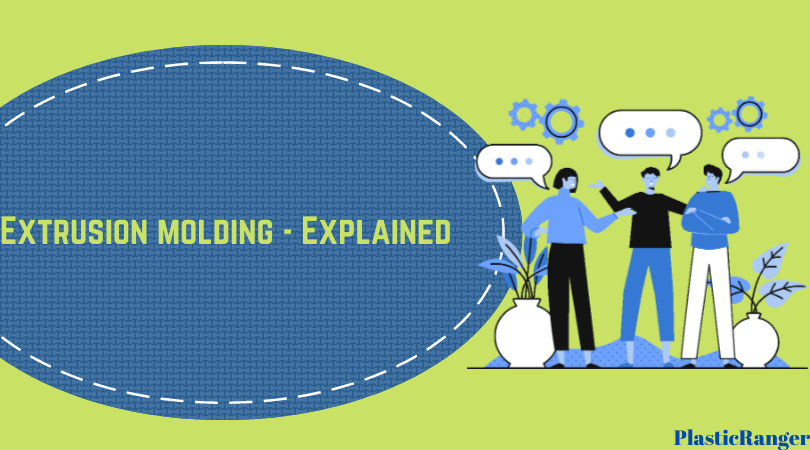What is Extrusion Process?

The extrusion molding process is one of the most extensively utilized techniques to manufacture long and straight metal parts. The key here is to force a metal piece to flow through a die to convert it into the desired shape.
The shape of the cross-section varies and can be manufactured according to your needs—shapes like rectangular, solid round, L shapes, T shapes, etc.
The extrusion process has many similarities to the drawing process, the key difference being the use of tensile stress for shaping the material. Although, extrusion molding has an edge overdrawing as it uses compressive stress and it allows large deformation.
Mostly all the thermoplastics are suitable for extrusion molding; however, materials with higher strength and stiffness in the molten form are considered the most convenient.
Extrusion molding – Explained –
Extrusion molding is a relatively straightforward process. As I mentioned earlier, it uses compressive force on a workpiece, and it does by using a piston or plunger. Let’s go through the entire extrusion process.
This can be a bit boresome, but bear with me, and it will be worth it.
First of all, a billet of standard size is produced. This billet will be heated at room temperature and then later will be kept on an extrusion press.
You might wonder what is an extrusion press? It can be picturized as a piston-cylinder device used to place metal in a cylinder and pushed by a piston.
Moving forward, we need to push the billet ahead towards the die. To do that, a compressive force has to be applied by a plunger fitted into the press.
The die-in through which the metal is supposed to flow is small in size compared to the cross-section. The applied compressive force plays a key role as it allows the work metal to flow through the die and covert into the preferred shape.
Finally, the extruded part is removed from the press and given heat treatment for better mechanical and chemical properties.
Types of Extrusion Molding – Explained

Two factors determine the type of extrusion used for specific tasks – 1) the flow of metal and 2) Working Temperature.
Let’s discuss both the factors and also the types of extrusion molding processes they would lead to.
According to the flow of metal –
Direct Extrusion –
Here, metal is forced in the direction of the feed of the punch. Thus, the punch is also forced to move towards die. Direct extrusion requires greater force due to higher friction between billet and container.
Indirect Extrusion –
In this process, metal and plunger are moving in the opposite direction. The die is also fitted at the opposite side of the punch movement. The metal has to flow through the annular space between punch and container.
Hydrostatic Extrusion –
This process is a bit different in terms of its application, and It uses fluid to pressure on the billet. And it’s different as the friction is eliminated as the billet is neither in contact with the billet nor the plunger.
There is the fluid present in between the billet and plunger. Force is applied to the fluid, which is further applied on both the plunger and billet.
The uncontrolled speed of extrusion helps in shaping the component.
Engaging Read – 7 Types of Plastics | An Helpful Illustrated Guide
According to the Working Temperature –
Hot Extrusion Method –
The Hot extrusion method, as the name suggests, is applied at fairly higher temperatures, which are about 50 to 75% more than the metal’s melting point. Adequate lubrication is a must to complete this process without hampering the quality of the die.
Oil, glass powder, and graphite are the most suitable lubricants for this process.
Talking about the pressure, it should range somewhere between 5076 – 101,525 psi.
Advantages of the hot extrusion method –
#1 The force requirement is low compared to cold extrusion.
#2 Stain hardening is not a thing in this method.
#3 It’s quite easy to work in the hot form ( meaning hot temperatures are necessary, and it doesn’t hurt the production. )
Cold Extrusion method –
This method works quite the opposite of hot extrusion as it works at room temperatures or slightly below room temperatures. The method is widely used to resist the stresses created by extrusion.
Advantages of hot extrusion method –
#1 Impressive mechanical properties.
#2 Negligible oxidation at the metal surface.
Fascinating Read – What is a Plastic Mold? | Parts of Plastic Mold | Applications of Plastic Mold
Applications of Extrusion Molding –

#1 Extrusion molding has a tremendous influence on the automobile industry. It produces various industry components like glass, windows, doors, frames, structural parts, Etc.
#2 Structural parts made by aluminum extrusion molding are widely used in oil industries.
#3 Tubes and hollow pipes are also among the most widely accepted products in extrusion molding, which are accepted in many industries.
#4 Construction industry is also supported by extrusion molding as it provides high-quality railings and construction equipment.
Advantages of Extrusion molding –

#1 The products can be manufactured at high speed, maintaining a high volume. So it’s fast and cost-effective at the same time.
#2 More on cost-effectiveness. It’s relatively inexpensive as the leftovers or waste can be recycled multiple times, and even the machinery itself can be worked 24 hours a day without spending much on additional maintenance.
#3 Extrusion molding allows us to produce flexible products with consistent cross-sections.
#4 Another crucial advantage extrusion molding has over other methods is allowing the post-extrusion alterations in the products. The products can be altered depending on the application when it is still warm.
Disadvantages of Extrusion molding –

#1 Size variation is one of the prominent negative points of extrusion molding. When the component exits the machine, it expands in size due to heat. The problem lies in not being able to gauge the expansion size.
The slight deviation in size might not give the products accurate dimensions.
#2 There are certain restrictions in the extrusion molding process as it can’t produce the product with a narrow end. Take an example of plastic bottles or bottle caps.
Because of their narrow shapes, it is impossible to produce them through extrusion molding. A manufacturer must rely on blow molding and injection molding alternatives in such a scenario.
Also Read – What is 3D Printing? | Types of 3D Printing | Applications of 3D Printing | Advantages & Disadvantages
The Takeaway –
Those were my views on the extrusion molding process. I hope you like my article and leave your reviews and questions in the comment box.
Peace Out!!!
Quick Navigation


Very nice article. However I was looking for extrusion of monofilaments in PP homopolymer.
Please do let me know what additives we can use to increase the tensile strength.
Very good article i want to know some more information please send me